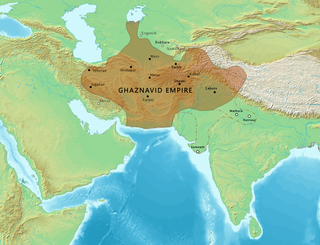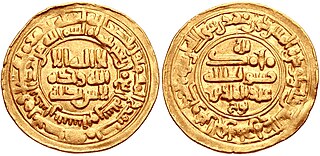
The Ghaznavid dynasty was a Muslim Turkic dynasty of mamluk origin, ruling at its greatest extent, large parts of Iran, Afghanistan, much of Transoxiana and the northwest Indian subcontinent from 977 to 1186. The dynasty was founded by Sabuktigin upon his succession to the rule of Ghazna after the death of his father-in-law, Alp Tigin, who was an ex-general of the Samanid Empire from Balkh, north of the Hindu Kush in Greater Khorasan.

The Samanid Empire also known as the Samanian Empire, Samanid dynasty, Samanid amirate, or simply Samanids) was a Sunni Iranian Empire, from 819 to 999. The Empire was centred in Khorasan and Transoxiana; at its greatest extent encompassing modern-day Afghanistan, huge parts of Iran, Turkmenistan, Uzbekistan, Kyrgyzstan, Tajikistan, and parts of Kazakhstan and Pakistan.

The Ziyarid dynasty was an Iranian dynasty of Gilaki origin that ruled Tabaristan from 931 to 1090. At its greatest extent, it ruled much of present-day western and northern Iran.

Nuh II was amir of the Samanids (976–997). He was the son and successor of Mansur I.

Abd al-Malik I was amir of the Samanid Empire from 954 to 961. He was the son and successor of Nuh I. His reign was marked by internal strife, with the Turkic slave-soldiers increasing in power. He died after falling from his horse during a game of polo at Bukhara; he was succeeded by his brother Mansur I, who was put on the throne by a faction of ghulams led by the Turkic slave-commander Fa'iq Khassa.

Ahmad ibn Ismail was amir of the Samanids (907–914). He was the son of Ismail Samani. He was known as the "Martyred Amir".

Nuh ibn Nasr, or Nuh I, was the amir of the Samanids in 943–954. He was the son of Nasr II. It is rumoured that he married a Chinese princess.

Nasr ibn Ahmad or Nasr II, nicknamed "the Fortunate", was the ruler (amir) of Transoxiana and Khurasan as the head of the Samanid dynasty from 914 to 943. His reign marked the high point of the Samanid dynasty's fortunes. He was the son of Ahmad ibn Isma’il.

Alp-Tegin, was a Turkic slave commander of the Samanid Empire, who would later become the semi-independent governor of Ghazna from 962 until his death in 963.
The Al-i Muhtaj or Muhtajids was an Iranian or Iranicized Arab ruling family of the small principality of Chaghaniyan. They ruled during the 10th and early 11th centuries.

Chaghaniyan, known as al-Saghaniyan in Arabic sources, was a medieval region and principality located on the right bank of the Oxus River, to the south of Samarkand.

Abu Ali Ahmad Chaghani was the Muhtajid ruler of Chaghaniyan (939–955) and governor of Samanid Khurasan. He was the son of Abu Bakr Muhammad.
Simjur al-Dawati was a 10th-century Turkic general who served the Samanids. He was the founder of the Simjurid family which would play an important role in the Samanid Empire.
Abu'l-Fadl al-Bal'ami, also known as Bal'ami the Elder, was a Samanid statesman from the al-Bal'ami family, who served as the vizier of Nasr II from 922 to 938.
Lili ibn al-Nu'man, also known as Lili ibn Shahdust, was the leader of the Shahanshahvand clan, and also ruled as the second king of the Gilites, ruling from the early 10th-century to 921. He served in high offices under his overlord the Zaydids. In 921, he invaded the territories of Samanids, conquering Damghan, Nishapur and Merv. He was, however, defeated and killed by a Samanid army under Abu'l-Fadl al-Bal'ami and Simjur al-Dawati. Lili was succeeded by Harusindan, who was a Gilite from another clan.
Ibrahim ibn Ahmad, was the amir of the Samanids briefly in 947. He was the son of Ahmad Samani.
Abu Mansur Muhammad ibn 'Abd al-Razzaq ibn 'Abdallah ibn Farrukh, also simply known as Abu Mansur Muhammad and Ibn 'Abd al-Razzaq, was an Iranian aristocrat who served the Samanids during the most of career, and briefly served as governor of Azerbaijan under the Buyids.
Abu'l-Hasan Ali ibn Fadl ibn Ahmad Isfarayini, commonly known as Abu'l-Hasan Isfarayini, was a Persian vizier of the Ghaznavid sultan Mahmud of Ghazni from 998 to 1010.
Mansur ibn Qara-Tegin, commonly known after his father as Ibn Qaratakin was a Turkic military officer of the Samanids in the mid-11th century.
Ibrahim ibn Simjur was a Samanid military officer from the Simjurid family.












